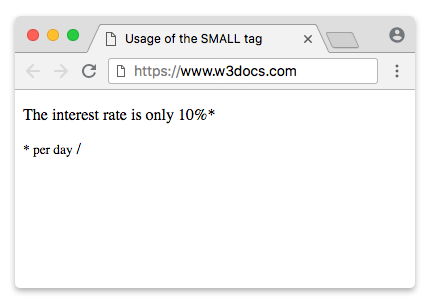The <small> tag decreases the text font size making it one size smaller than a document's base font size (from medium to small, or from x-large to large).
In HTML, the font size is measured by conventional units from 1 to 7. By default, the average font size of the text is three units. Furthermore, the size of the font depends on its type. For example, Arial font is bigger than Times but smaller than Verdana.
The <small> tag usually contains the items of secondary importance such as copyright notices, side comments, or legal notices.
You can put <small> tag into another <small> tag, thus the font of the text is minimized in correspondence with the “depth” of the content.
Although the <small> tag, like the <i> and <b> tags, may be considered as violating the rule of separation between structure and presentation, they are valid in HTML5.
Syntax
The <small> tag comes in pairs. The content is written between the opening (<small>) and closing (</small>) tags.
Example of the HTML <small> tag:
<!DOCTYPE html>
<html>
<head>
<title>Usage of the SMALL tag</title>
</head>
<body>
<p>The interest rate is only 10%*</p>
<small>* per day</small> /
</body>
</html>Result

Example of the HTML <small> tag inside a <div> tag:
<!DOCTYPE html>
<html>
<head>
<title>Usage of the SMALL tag</title>
</head>
<body>
<h1>Small tag example</h1>
<p>The is a some text.</p>
<div>
<p>
Lorem ipsum, or lipsum as it is sometimes known, is dummy text used in laying out print, graphic or web designs. The passage is attributed to an unknown typesetter in the 15th century who is thought to have scrambled parts of Cicero's De Finibus Bonorum et Malorum for use in a type specimen book.
</p>
<small>This is a small text.</small>
</div>
</body>
</html>Attributes
The <small> tag supports the Global attributes and the Event Attributes.
How to style <small> tag?
Common properties to alter the visual weight/emphasis/size of text in <small> tag:
- CSS font-style property sets the style of the font. normal | italic | oblique | initial | inherit.
- CSS font-family property specifies a prioritized list of one or more font family names and/or generic family names for the selected element.
- CSS font-size property sets the size of the font.
- CSS font-weight property defines whether the font should be bold or thick.
- CSS text-transform property controls text case and capitalization.
- CSS text-decoration property specifies the decoration added to text, and is a shorthand property for text-decoration-line, text-decoration-color, text-decoration-style.
Coloring text in <small> tag:
- CSS color property describes the color of the text content and text decorations.
- CSS background-color property sets the background color of an element.
Text layout styles for <small> tag:
- CSS text-indent property specifies the indentation of the first line in a text block.
- CSS text-overflow property specifies how overflowed content that is not displayed should be signalled to the user.
- CSS white-space property specifies how white-space inside an element is handled.
- CSS word-break property specifies where the lines should be broken.
Other properties worth looking at for <small> tag:
- CSS text-shadow property adds shadow to text.
- CSS text-align-last property sets the alignment of the last line of the text.
- CSS line-height property specifies the height of a line.
- CSS letter-spacing property defines the spaces between letters/characters in a text.
- CSS word-spacing property sets the spacing between words.
Browser support
|
|
|
|
|
|
|---|---|---|---|---|
| ✓ | ✓ | ✓ | ✓ | ✓ |
Practice Your Knowledge
Quiz Time: Test Your Skills!
Ready to challenge what you've learned? Dive into our interactive quizzes for a deeper understanding and a fun way to reinforce your knowledge.